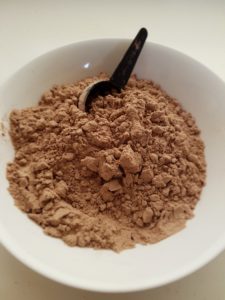Archive for the ‘Blogs’ Category
Posted on January 11th, 2017 in
BlogsI have seen a number of clients who increase their exercise but either don’t lose weight or even gain weight. What could be happening here?
For some muscle development from significant exercise can appear as weight gain or a plateau in the weight loss arena, simply because muscle weighs more than fat. The questions here are: Do you feel better, stronger, fitter? Are your clothes fitting better? Numbers on a scale aren’t the be all and end all of being healthy.

Protein powder – cacao of course
For others who don’t seem to be losing weight despite undertaking extra exercise, there could be something else going on…
Doing a workout doesn’t earn you extra kilojoules for cunsumption if you are trying to lose weight. The key to weight loss is to go into energy deficit or negative energy balance (that is, consume less energy (kilojoules) than you expend). Too often I see people wanting to lose weight so they exercise like crazy only to eat larger portions or additional snacks.
The other pitfall is the protein shake or bar after a workout, which is often not counted because it is considered ‘post workout protein recovery for muscle repair’. A protein shake can have the energy density of a meal (a protein shake for me is my entire meal) and can be a hidden danger for people trying to lose weight. And for the vast majority of us a one-hour workout at the gym probably doesn’t require masses of protein to be consumed. It would be wise to time your workouts pre- breakfast, lunch or dinner and ensure that those meals have a reasonable protein source.
Have a think about making some small adjustments to get weight loss back on track.
Posted on January 11th, 2017 in
BlogsIt’s that time of year when all the weight loss companies are sprouting their wares on television – trying to cash in on your new year resolutions. Many of you might be considering some of these programs as an option or considering going on a short term calorie restrictive detox or diet.
You will notice that this post comes later than all the new year’s resolution posts. There’s a method in my madness. By now many of you will have stumbled through the holiday period, made a resolution and then realised there’s Australia Day to contend with…so the diet went on the back burner.
My struggle with new year resolutions around dieting and detoxing is that severely restricting calorie consumption can lead to cravings, slower metabolism and rebound weight.
Over 90% of people who lose weight on a severely restricted calorie diet will regain the weight they have lost and gain more within 3 years.
So this year, why not try adding in loads of vegetables to fill up your tummy rather than trying to drop so-called ‘bad’ foods out. Being healthy and maintaining a preferred body weight takes lots of work over a life time not just a month or two.
This year why not consider ‘not dieting’ but filling up on vegetables and wholefoods as your new year intention?
Posted on January 11th, 2017 in
BlogsI love a dessert as much as anyone. Give me anything with pastry and any combination of dark chocolate, salted caramel and crème patissiere and I am done for! I will devour it – no questions asked. But here’s the rub I only do that ever so occasionally. It’s a treat.
If I have a hankering for something sweet then it’s sated by usually a piece of fruit, a couple of tablespoons natural yoghurt with a light drizzle of maple syrup or honey, or a couple of small pieces of good quality dark chocolate (about 20g)…and that’s not every night.
 Over the last few years we have seen the rise of the raw dessert. They are delicious and what makes them even better they are made from beautiful unprocessed ingredients including: mejool dates, other dried fruit, raw honey, maple syrup, raw cashews and other nuts and seeds, fruits and vegetables, coconut oil, cacao butter. Oh so yummy!
Over the last few years we have seen the rise of the raw dessert. They are delicious and what makes them even better they are made from beautiful unprocessed ingredients including: mejool dates, other dried fruit, raw honey, maple syrup, raw cashews and other nuts and seeds, fruits and vegetables, coconut oil, cacao butter. Oh so yummy!
The trouble is that because they’re raw and contain highly nutritious ingredients and because they don’t have refined sweeteners in them we tend to think of them as the ‘healthy’ alternative. The truth is that they can be (and mostly are) very energy dense meaning that they have a very high kilojoule count. Whilst I don’t prescribe to the simplified concept that a kilojoule is a kilojoule (you can get vastly different nutrient profiles from foods with the same energy content) I still believe we need to be careful not to over-consume.
Another thing that is important to remember is that at the end of the day choosing to eat honey, agave syrup, maple syrup or rice malt syrup is not so different to eating sugar. In a nutshell our bodies convert these other sweeteners to glucose just as it does with table sugar. Sweeteners generally provide high energy for very little nutritional value.
Eating these raw dessert can also crowd out room in your daily diet for energy-low nutrient-dense foods like fresh fruits and vegetables.
So if weight loss or weight management is part of your journey then limit your consumption of raw food desserts as you would any other dessert. If you are consuming more energy than you use then the very real likelihood is that you will gain weight.
Remember all desserts are treat foods – raw or not. So enjoy a treat every now and then as part of a great well-balanced holistic food plan.
Posted on December 31st, 2015 in
BlogsLink to my blog about eating for exercise for The Golden Door Elysia:
https://www.goldendoor.com.au/fuel-for-movement/
Posted on October 30th, 2015 in
BlogsParabens??
Parabens. Heard of them? Yep! Know what they are? Nope!
We’ll let’s see if I can help out here…briefly.
Parabens are a class of chemicals widely used in toiletries and cosmetics as a preservative. They are also used as fragrances in some cosmetics. You will see them listed on products as methylparaben, butylparaben, propylparaben, isobutylparaben and ethylparaben.
Parabens occur naturally at low levels in some foods. But many of the parabens used in cosmetics are synthesised from petrochemicals. When parabens in food are eaten they are metabolised but when applied to the skin (as soaps, shampoos and conditioners, lotions and moisturisers, makeup, deodorants and even toothpaste) they aren’t metabolised in the same way…they are absorbed by the body and simply enter the blood stream and then body’s organs.
Parabens act as endocrine disrupters and can interfere with hormone function by mimicking the female sex hormone oestrogen. Parabens have been found in breast cancer tissue samples suggesting a link between parabens and cancer. They are also linked with neurotoxicity, immunotoxicity and skin irritation.
So why not check how many of your bathroom products contain parabens and start to replace them with paraben-free alternatives?
http://www.safecosmeticsaustralia.com.au/p/toxic-free-list.html
Posted on December 2nd, 2014 in
BlogsThe festive season is really ‘feasting’ season for many of us…and all that we have strived hard to achieve throughout the year gets pushed to one side as we attend function after function. Take a moment to sit back, breathe and take stock of how far you have come and how you will continue to move forward…
Click here to read my current blog for the Golden Door Elsyia.
Posted on November 28th, 2014 in
BlogsI was recently asked to answer some questions about acrylamide for US magazine Today’s dietitian (article here). I had previously written a short piece for my Facebook page about acrylamide and given the question of acrylamide had reared its head again I thought it might work as my first blog.
So what is acrylamide and why do I think you should know about it? Acrylamide is a chemical used industrially to make polyacrylamide and acrylamide copolymers that are used in the manufacture of papers, dyes and plastics to name but a few.
Acrylamide is also a naturally occurring chemical compound that appears or develops in foods that have been cooked. It occurs in baked, fried, grilled and toasted foods but not in foods that have been boiled or steamed. They are prevalent in starchy foods such as potatoes, grains and breads that have cooked to high temperatures and usually browned…the darker the browning the more acrylamide in the food.
What does it do? As a toxic by-product of the cooking process it has been shown in lab tests that it can cause cancer in animals. Acrylamide might also cause neurological damage with high and frequent exposure. The other main source of acrylamide exposure to humans is cigarette smoke.
Although the ‘experts’ are saying that there is no direct evidence to suggest that it causes cancer in humans they are suggesting that it would be prudent to minimise our exposure to acrylamide (read that as “better safe than sorry”!). The old adage “the dose makes the poison” rings true here – if we are exposed to trace elements of acrylamide in manufactured products (including food wrapping) as well as higher levels of acrylamide in foods then how much is our dose?
So how do you avoid or minimise acrylamide consumption? This is relatively easy… avoid or significantly reduce the following foods:
• Potato crisps
• Hot potato chips / French fries
• Baked goods (including sweet biscuits)
• Roasted potatoes (cook until only lightly golden and eat less of them)
• Heavily toasted bread (toast only very lightly)
• Coffee
• Wheat-biscuit style breakfast cereals
And…opt out of using plastic and, quit smoking and avoid second-hand smoke.
When you think about it, the foods listed above are foods that are best eaten in small quantities and should be considered treat foods as part of a balanced diet.
Eat well – stay well.



 Over the last few years we have seen the rise of the raw dessert. They are delicious and what makes them even better they are made from beautiful unprocessed ingredients including: mejool dates, other dried fruit, raw honey, maple syrup, raw cashews and other nuts and seeds, fruits and vegetables, coconut oil, cacao butter. Oh so yummy!
Over the last few years we have seen the rise of the raw dessert. They are delicious and what makes them even better they are made from beautiful unprocessed ingredients including: mejool dates, other dried fruit, raw honey, maple syrup, raw cashews and other nuts and seeds, fruits and vegetables, coconut oil, cacao butter. Oh so yummy!